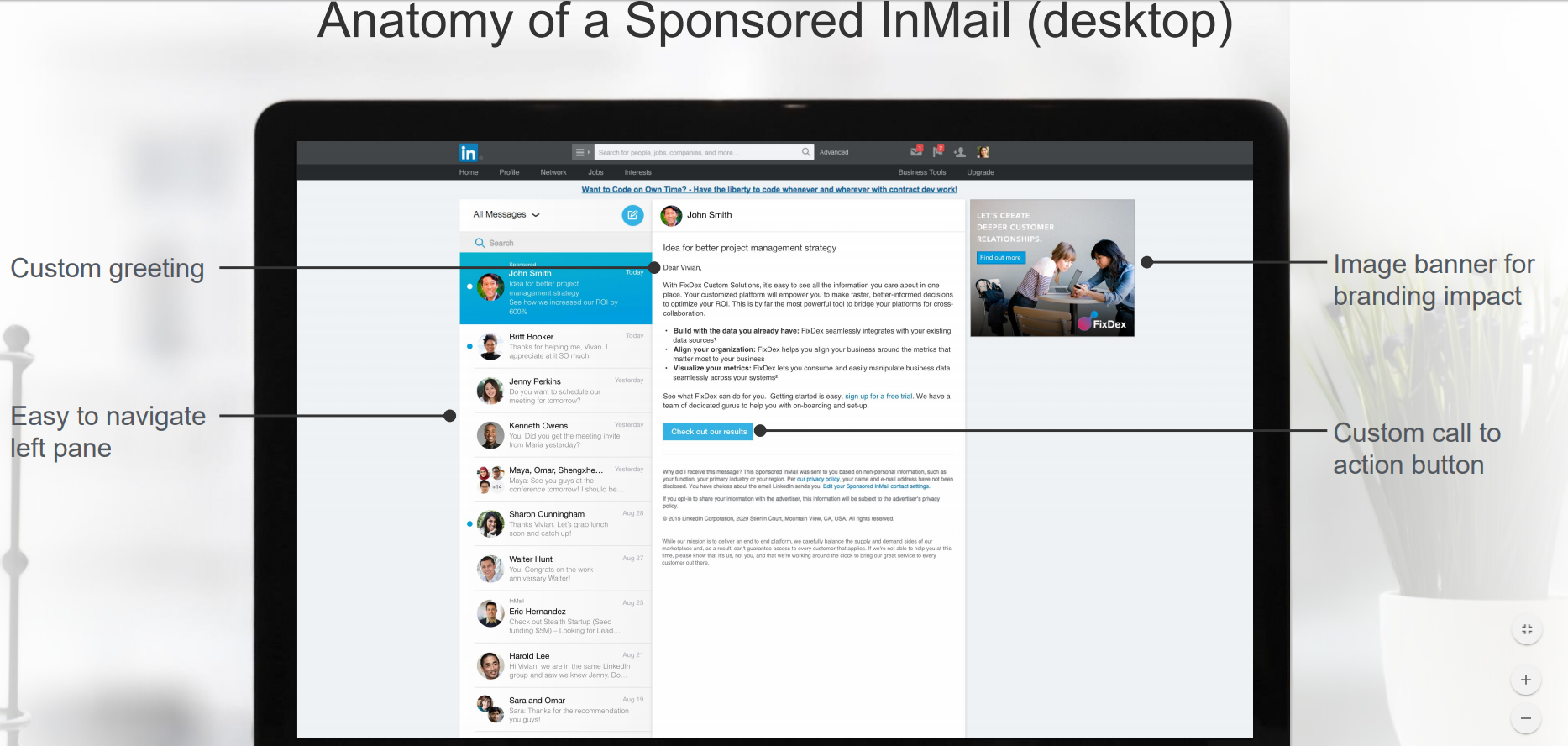Don’t have email addresses for everyone on your marketing list? Try adding LinkedIn Sponsored InMail as a touchpoint to your next campaign.
How Does LinkedIn Sponsored InMail Work?
Sponsored InMail offers a great way to digitally reach prospects outside of the email inbox. Sponsored InMail delivers a message you create—much like a standard LinkedIn message—to the LinkedIn inbox of your selection or your targeting. It’s like sending an email to someone, except you don’t have to have that person’s email address for the message to reach them.
Setting Goals for Sponsored InMail
As with any campaign, your first step in the planning process is to set a goal and a purpose. What do you want to achieve with this campaign? Are you trying to get people to visit your booth at a trade show? Do you want to let a category of people know about a new industry-specific offering? Are you targeting LinkedIn users who have a specific skillset with a recruitment message?
From there, you can determine how much you want to spend on this campaign by placing a conversion goal on the InMail portion of your campaign—if you generate X number of opportunities, and your close rate is Y, you can work backward to build a reasonable budget with an obtainable number of opportunities generated.
Sponsored InMail campaigns have compelling metrics—you can benchmark your numbers based on these general results:
- High deliverability—Sponsored InMail is only delivered if (and when) a user logs into LinkedIn
- 35-50% open rate is average, but opens can exceed 70%
- Average click through rate on ads is 4 to 6%, but close rate is on you!
Thinking through Your Sponsored InMail Strategy
To build out a Sponsored InMail campaign, start by thinking about how you want to layer your audience targeting. Do you want to cast a wide net? Do you know the specific job titles you want to target but not the exact people? Do you have a list of contacts or companies in mind that you want to reach? You have several options for targeting with a Sponsored InMail campaign:
- Account-Based Marketing: If you want to target specific companies, you can upload a list of companies (and their associated websites) as a starting place for campaign targeting. From there, you can further filter on everything from skills to location to job title or job function, and let LinkedIn take care of the rest. The suggested list size for this approach is 1,000 companies, but you can run a campaign with as few as 300 companies.
- Customer/Contact List: Already have the email addresses and just want to add another personal touchpoint? You can upload a CSV of contacts and associated email addresses and target specific people who are already in your pipeline. The suggested list size for this approach is 10,000 email addresses, but you can run a campaign with as few as 300 matched members.
- General Audience Layers: If you don’t have a list of accounts or contacts to start with, you can use the same targeting layers you could use in a sponsored content campaign to build your own list based on industry, location, job title, job function, skills, etc.

A Few Recommendations for Your InMail Content
Now that you have a list, a goal, and a purpose, you can craft content. The following items are helpful to keep in mind as you think through conversions on these Sponsored InMails:
- Keep subject lines short (a large number of users are on mobile)
- Customize messages (like you would in email) with variables on name, company, job title, etc.
- All InMail includes a visual ad alongside the message—if you don’t provide this, LinkedIn will automatically choose one for you. Ad size for this space is 300×250 pixels.
- Keep your copy under 1,000 characters (not words)
- Include links and calls to action in the body of your message
- Customize your button text to align with your call to action
- If you have multiple functions within your target audience, consider creating separate messages per audience type
- Add terms and conditions, if you need to
Who Do Sponsored InMails Come From?
Sponsored InMail is distributed through a point of contact who is attached to your LinkedIn Company Page, so choose your sender wisely. Each Sponsored InMail you send will appear to come from that sender. You will need to:
- Connect with the person or people you want to use as senders
- Determine your segmentation strategy—from regional sales people? By product line?
- Make sure the sender is credible, influential, knowledgeable, and ready to respond!
Want to learn more about integrating Sponsored InMail into your digital marketing toolbox? Let’s talk strategy!




Great article Natalie, we recently run a successful Sponsored InMail campaign for an international food and beverage company. The campaign generated one particular meeting, which led to the signing of a very lucrative contract.
So, Sponsored InMail is worth the effort.
Thanks for the feedback, Robin! I’m so glad to hear Sponsored InMail works for you–it can be such a great tool!
Hi Natalie,
How do you actually use variables in InMail?
I.E. does [company_name] when saved into a template result in the candidate’s company name when selecting inmail from template?
So far I haven’t found a list of these variables.
Cheers,
Cameron
Hi Cameron,
Variables are limited in InMail as of now, but you should see options (including company) in a drop down menu as you build the InMail text within LinkedIn.
My only problem is that this method does not allow organic response. It prefers recipients to click a canned button.